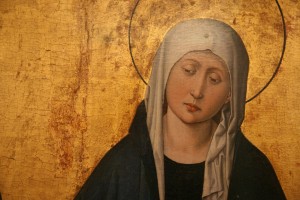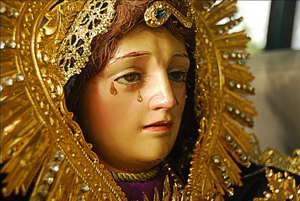 Today we honor Our Lady under the title of Our Lady of Sorrows. This feast is so intimately connected with yesterday’s feast of the Exaltation of the Holy Cross. You know the image of the Mother of God, the mother of a son, at the foot of the cross in great pain, sorrow, yet hope that all is not lost. Personally, I also recall the fact of Our Lady of Sorrows when I pray for a family who is grieving the loss of a loved one; and in a more extended way for me, OL of Sorrows is the prime patroness of the Congregation of Holy Cross (who educated me in high school and in university). In this latter fact, I hope and pray Mary is watching over the the CSC and Notre Dame in a keen way especially these days of spiritual combat. Nevertheless, Mary’s real, concrete experience the Life-Saving Cross is crucial to my understanding the mysteries of life and death.
Today we honor Our Lady under the title of Our Lady of Sorrows. This feast is so intimately connected with yesterday’s feast of the Exaltation of the Holy Cross. You know the image of the Mother of God, the mother of a son, at the foot of the cross in great pain, sorrow, yet hope that all is not lost. Personally, I also recall the fact of Our Lady of Sorrows when I pray for a family who is grieving the loss of a loved one; and in a more extended way for me, OL of Sorrows is the prime patroness of the Congregation of Holy Cross (who educated me in high school and in university). In this latter fact, I hope and pray Mary is watching over the the CSC and Notre Dame in a keen way especially these days of spiritual combat. Nevertheless, Mary’s real, concrete experience the Life-Saving Cross is crucial to my understanding the mysteries of life and death.
The great Cistercian abbot and author of many works on the Holy Virgin, St. Bernard of Clairvaux has this to say to us:
Truly, O blessed Mother, a sword has pierced your heart. For only by passing through your heart could the sword enter the flesh of your Son. Indeed, after your Jesus—who belongs to everyone, but is especially yours—gave up his life, the cruel spear, which was not withheld from his lifeless body, tore open his side. Clearly it did not touch his soul and could not harm him, but it did pierce your heart. For surely his soul was no longer there, but yours could not be torn away. Thus the violence of sorrow has cut through your heart, and we rightly call you more than martyr, since the effect of compassion in you has gone beyond the endurance of physical suffering.
~(Sermo in dom. infra oct. Assumptionis, 14-15: Opera omnia, Edit. Cisterc. 5 [1968}, 273-274) is used in the Roman Office of Readings for the Feast of Our Lady of Sorrows on September 15.
~(The image was written by Connecticut iconographer Marek Czarnecki.)





